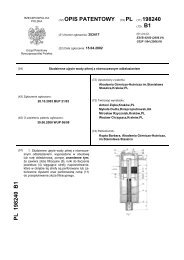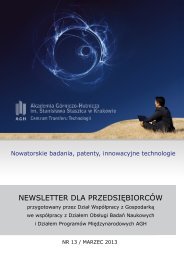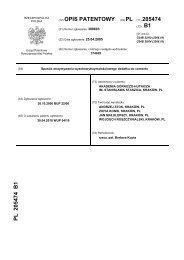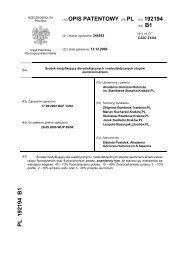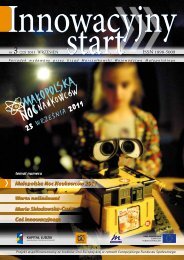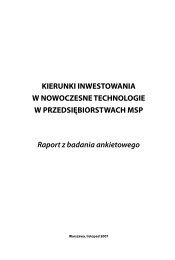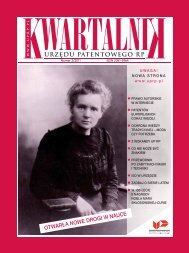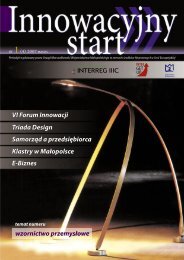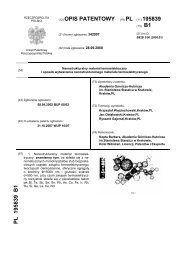Wyd. specjalne/2011 - Regionalny OÅrodek Informacji Patentowej ...
Wyd. specjalne/2011 - Regionalny OÅrodek Informacji Patentowej ...
Wyd. specjalne/2011 - Regionalny OÅrodek Informacji Patentowej ...
- No tags were found...
Create successful ePaper yourself
Turn your PDF publications into a flip-book with our unique Google optimized e-Paper software.
Cały taki system ocieplenia, w przypadku jegostosowania na etapie konstrukcji budynku, jestumieszczany pomiędzy warstwami konstrukcji,na przykład między murowaną warstwąkonstrukcyjną i murowaną warstwą osłonową(która następnie jest tynkowana i malowana).A review of the case law of the Polish Patent Office concerningindustrial designsIndustrial designs in litigation casesTak więc w przedmiotowej sprawie mieliśmydo czynienia z wzorem stosowanym w częściskładowej (warstwie ocieplającej) wytworuzłożonego (systemu ocieplenia). W rozumieniuart. 102 ust. 3 pkt. 1 pwp i zgodnie z treściąprzepisu art. 102 ust. 4 pwp Urząd jest zobowiązanydo oceny nowości i indywidualnegocharakteru przedmiotowego wzoru przemysłowegojedynie w zakresie cech widocznychcałego tego wytworu złożonego, tj. w zakresiecech płyt izolacyjnych widocznych podczaszwykłego używania systemu ocieplenia,przez które rozumie się jego używanie przezużytkownika końcowego, z wyłączeniemkonserwacji, obsługi lub naprawy (art. 3 ust. 4powołanej dyrektywy 98/71/WE).Końcowy użytkownik przedmiotowej płytyizolacyjnej, wkomponowanej w system ociepleniabudynku, tj. administrator lub właściciel,ewentualnie lokator tego budynku nie mamożliwości wzrokowego postrzegania cech tejpłyty w trakcie zwykłego używania tego systemuocieplenia, tj. w trakcie zamieszkiwaniadanego budynku.W świetle powyższego, ponieważ żadnacecha przedmiotowej płyty izolacyjnej nie jestwidoczna w ukończonym systemie ocieplającympodczas zwykłego jego używania, jakozakrytej kolejnymi warstwami budowlanymi(np. warstwą zbrojoną siatką z włókna szklanego,warstwą gruntującą i warstwą elewacyjnąw postaci tynku), wskazana płyta izolacyjnanie może być przedmiotem wzoruprzemysłowego określonego w art. 102ust. 1 pwp i zarzut wnioskodawcy opartyna tej podstawie jest zasadny.Wobec powyższego Kolegium nie mogłodokonać oceny nowości i indywidualnegocharakteru przedmiotowego wzoru przemysłowegow świetle przeciwstawionych(i przedłożonych przez uprawnionego) materiałów.Ponadto, zbędne stało się rozstrzygnięciezasadności zarzutu, że przedmiotowy wzórnie może stanowić wzoru przemysłowegow rozumieniu art. 102 pwp, gdyż nie posiadaustalonej postaci.I would like to present two examples of the relevantPolish Patent Office case law in orderto illustrate what kind of problems can arisein litigation cases concerning invalidity of a rightin registration for an industrial design.The first example concerns a situation,where introduction of small changesin the known form of an industrial designdoes not change the overall impressionwhich it makes on an informed user,and a situation, where a ruling by a commoncourt decides on an infringement of personalor economic rights through the use of a givenindustrial design.In the discussed case, an opposition was filedwith the Patent Office by company X from Kielceconcerning the decision of the Office to granta right in registration for an industrial design“Ceramic plate with a decoration ‘LATO’ ” no.Rp-11 434. In view of the owner’s claim thatthe opposition was groundless, the case wastransferred to be decided within the litigationprocedure.The opposing party indicated Articles 102,104 and 117(2) of the Industrial Property Law(IPL) claiming that the said industrial design didnot have individual character (Article 104 IPL)on the date of its filing for protection, and its useinfringes author’s economic rights of the opposingcompany (Article 117 (2) IPL) .The Kielce company had exclusive author’s rightsto the complete composition of the ceramicplate model with a commercial name “Almeria”which had been manufactured by it and introducedon the market more than two yearsbefore the priority date of the design in question.In the opinion of the opposing company,the said design constitutes a copy of the plates“Almeria”, because of the use of the floral motifof a dandelion, the motif of the combinationof several butterflies with the same floral motif,the background in the form of unevenly arrangedfruit with a plume, the motif of stylized contourof a stalk and proportions of butterflies and theirpositioning.To support its arguments, the opposing partypresented, among others, legally valid rulingof the Court of Appeal, in which the Courtdecided that the use of the design in questioninfringed author’s economic rights of the opposingcompany to the composition of the plates“Almeria”, as well as their catalogue and VATinvoices from 2004 comprising the item “Almeriabeige”.The design owner argued, that the subjectof the litigation made on an informed user, i.e.a person professionally buying such plates orresearching the market in order to buy them,a different impression than plates “Almeria” dueto the clear “picture” of a butterfly (while in “Almeria”plates there are moths), different arrangementof the other butterflies on the plate, and its differentcolours and texture, so it was featured by itsindividual character. Besides, a plate accordingto the present design did not infringe author’seconomic rights of the opposing companyto the composition of the plates “Almeria”.The Office considered that, everybody can filejustified opposition against legally valid decisionof the Patent Office to grant a right in registrationfor an industrial design (Article 246(1) IPL), and ifthe proprietor in the answer to the oppositionraises an objection that the opposition is groundless,the case is transferred to be decided withinthe litigation procedure (Article 247(2) PWP).According to the rule of Article 246(2) IPL,the grounds for opposition are the circumstanceswhich justify invalidation of a right in registration.Whereas according to the Article 255(1)(9)IPL, cases concerning the invalidation of a rightin registration as a result of an opposition consideredgroundless are decided by the Patent Officeof the Republic of Poland within the litigationprocedure, wherein the Office shall settle casesin litigation procedure within the scope of the requestand shall be bound by the legal groundsindicated by the requesting party. Apart fromthe above, it should be stressed that, in the presentcase, the industrial design “Ceramic platewith a decoration ‘LATO’ ” (no. Rp-11 434) wasfiled for registration on 14 September 2006, sothe Industrial Property Law was used for the purposeof examination of the legal conditions necessaryto grant protection for the said design.<strong>Wyd</strong>anie <strong>specjalne</strong> KWARTALNIK URZĘDU PATENTOWEGO RP • 75




